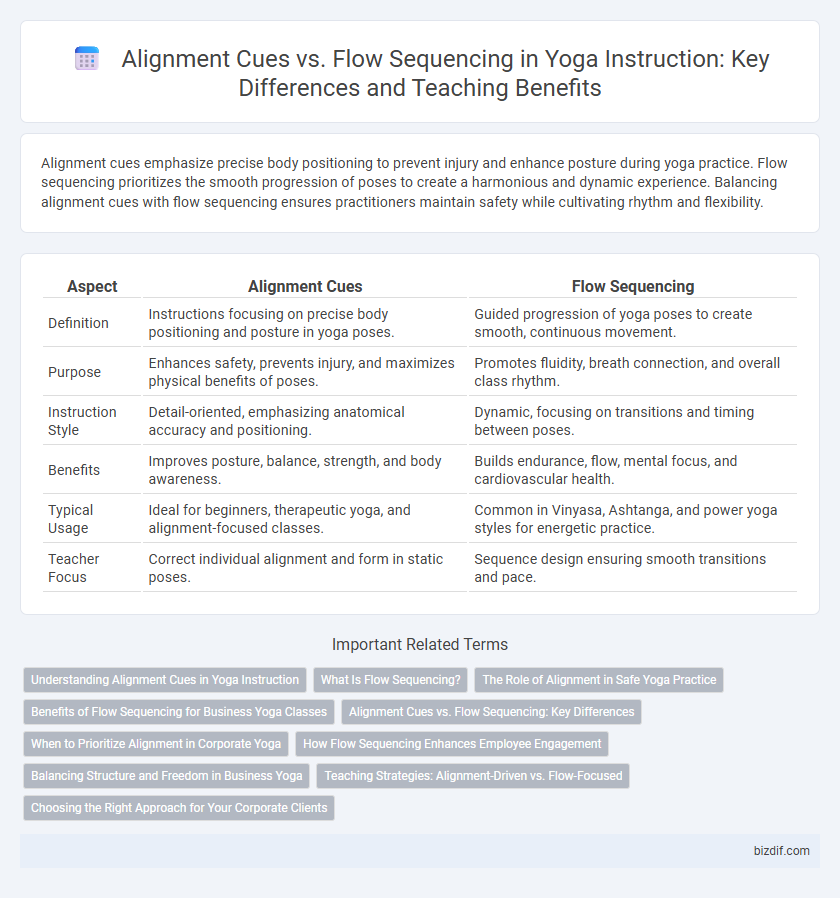Alignment cues emphasize precise body positioning to prevent injury and enhance posture during yoga practice. Flow sequencing prioritizes the smooth progression of poses to create a harmonious and dynamic experience. Balancing alignment cues with flow sequencing ensures practitioners maintain safety while cultivating rhythm and flexibility.
Table of Comparison
| Aspect | Alignment Cues | Flow Sequencing |
|---|---|---|
| Definition | Instructions focusing on precise body positioning and posture in yoga poses. | Guided progression of yoga poses to create smooth, continuous movement. |
| Purpose | Enhances safety, prevents injury, and maximizes physical benefits of poses. | Promotes fluidity, breath connection, and overall class rhythm. |
| Instruction Style | Detail-oriented, emphasizing anatomical accuracy and positioning. | Dynamic, focusing on transitions and timing between poses. |
| Benefits | Improves posture, balance, strength, and body awareness. | Builds endurance, flow, mental focus, and cardiovascular health. |
| Typical Usage | Ideal for beginners, therapeutic yoga, and alignment-focused classes. | Common in Vinyasa, Ashtanga, and power yoga styles for energetic practice. |
| Teacher Focus | Correct individual alignment and form in static poses. | Sequence design ensuring smooth transitions and pace. |
Understanding Alignment Cues in Yoga Instruction
Understanding alignment cues in yoga instruction enhances practitioners' body awareness and safety by emphasizing precise positioning of joints, muscles, and breath. These cues guide in preventing injuries and improving posture, enabling more effective energy flow and stability during poses. Mastery of alignment fundamentals supports smoother transitions and deeper engagement in flow sequencing practices.
What Is Flow Sequencing?
Flow sequencing in yoga involves arranging postures in a fluid, continuous manner to create a harmonious practice that emphasizes smooth transitions and breath synchronization. This method enhances cardiovascular benefits, encourages mindfulness, and maintains energy throughout the session. Unlike alignment cues that prioritize static posture precision, flow sequencing prioritizes movement integration and rhythm to cultivate balance and endurance.
The Role of Alignment in Safe Yoga Practice
Precise alignment cues are essential for preventing injuries and ensuring safe yoga practice by guiding practitioners to maintain proper joint and body positioning. Proper alignment helps distribute weight evenly, reduces strain on muscles and ligaments, and enhances the effectiveness of each pose. Focusing on alignment over rapid flow sequencing allows students to build strength, balance, and body awareness while minimizing the risk of overextension or misalignment.
Benefits of Flow Sequencing for Business Yoga Classes
Flow sequencing in business yoga classes enhances participant engagement by creating a seamless progression of postures that builds energy and maintains interest. This dynamic approach supports stress reduction and mental clarity, which are key benefits for workplace wellness programs. Incorporating flow sequences increases class retention rates and attracts more clients by offering a balanced mix of movement and mindfulness.
Alignment Cues vs. Flow Sequencing: Key Differences
Alignment cues emphasize precise body positioning, promoting safety and injury prevention during yoga practice. Flow sequencing prioritizes the smooth transition between poses, enhancing rhythm and cardiovascular benefits. Understanding these key differences helps instructors tailor sessions to either detailed technique or dynamic movement flow.
When to Prioritize Alignment in Corporate Yoga
Prioritize alignment cues in corporate yoga sessions when participants perform foundational poses to ensure safety and prevent injury, especially for beginners or individuals with limited flexibility. Emphasizing precise alignment enhances posture correction and supports ergonomic benefits relevant to office workers. In contrast, flow sequencing can be introduced later to boost cardiovascular health and mental focus once alignment principles are well established.
How Flow Sequencing Enhances Employee Engagement
Flow sequencing in yoga instruction enhances employee engagement by creating a structured yet dynamic practice that maintains interest and motivation. Strategic arrangement of poses supports physical and mental progression, fostering a sense of accomplishment and continuous challenge. This approach encourages active participation and sustained focus, leading to improved well-being and productivity among employees.
Balancing Structure and Freedom in Business Yoga
Alignment cues in business yoga ensure precise postural integrity, reducing injury risk and enhancing practitioner confidence, while flow sequencing promotes fluidity and adaptability to varying skill levels. Balancing structure and freedom enables instructors to tailor sessions that maintain safety and consistency without stifling creativity or personal expression. This dynamic approach fosters client engagement, satisfaction, and sustainable practice growth in a corporate wellness setting.
Teaching Strategies: Alignment-Driven vs. Flow-Focused
Alignment-driven teaching strategies prioritize precise body positioning to prevent injury and enhance physical benefits, emphasizing anatomical cues and muscle engagement. Flow-focused instruction centers on seamless transitions and rhythm, encouraging breath-synchronized movements that build fluidity and mindfulness. Balancing both approaches allows instructors to create classes that cultivate strength, safety, and an immersive practice experience.
Choosing the Right Approach for Your Corporate Clients
Alignment cues emphasize precise body positioning to prevent injuries and enhance posture, crucial for corporate clients with sedentary lifestyles. Flow sequencing promotes continuous movement and breath synchronization, reducing stress and boosting mental clarity in high-pressure work environments. Selecting the right approach depends on the specific needs of corporate clients, balancing physical alignment for long-term health with flow to improve focus and energy levels.
Alignment cues vs Flow sequencing Infographic

 bizdif.com
bizdif.com